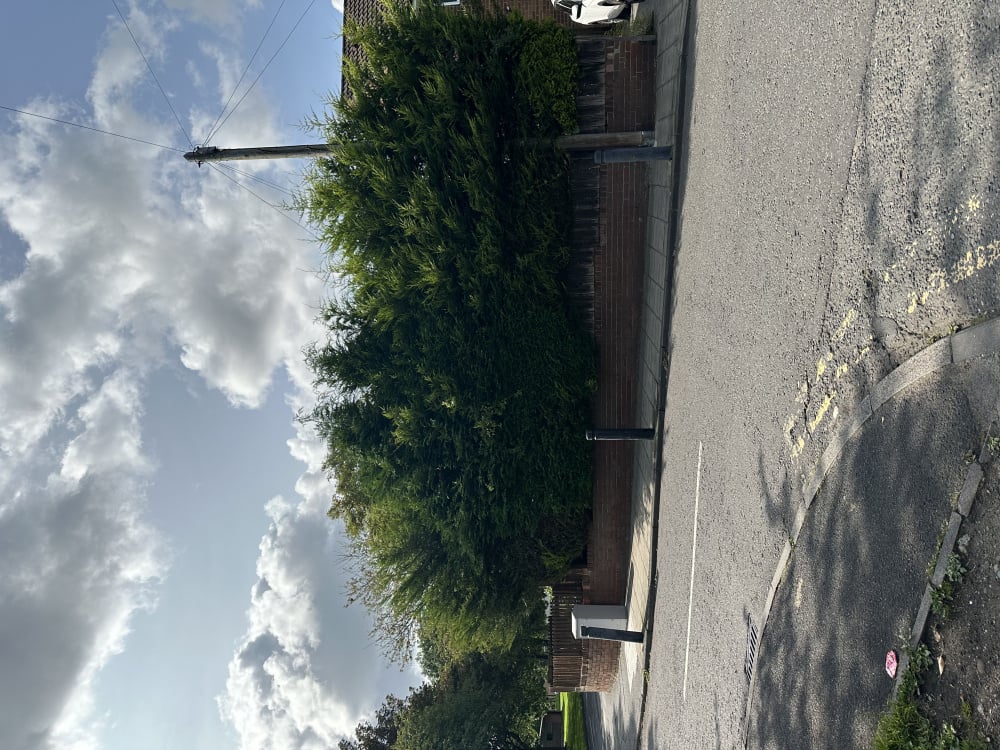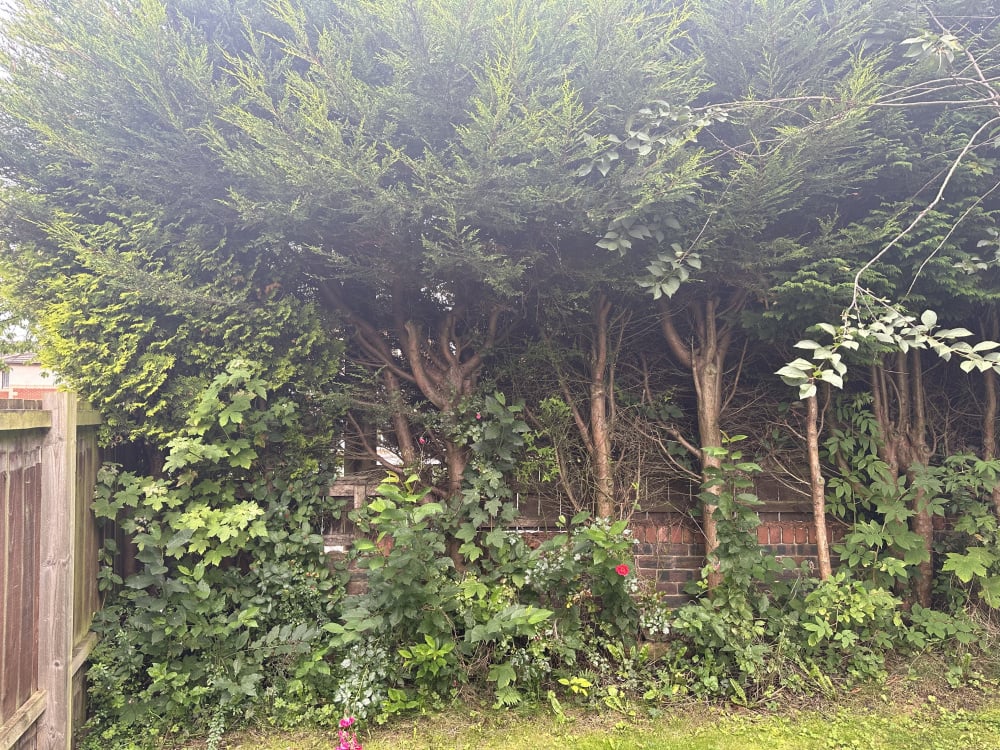This Forum will close on Wednesday 27 March, 2024. Please refer to the announcement on the Discussions page for further detail.
What privacy hedge or tree can I replace my dying (or dead) Leylandii?

 Evening everyone,
Evening everyone, First and foremost I am a complete novice when it comes to gardening or anything beyond cutting the grass so please be patient with me
I've purchased my first home and thinking ahead to next year I am wanting to do a bit of landscaping and improving my garden. I have a corner house and part of what I call my 'back garden' extends beyond the front of the house and abuts the main road and footpath, which is where my leylandii trees (or at least I think they are leylandii) are currently in situ.
From the looks of things, the previous owner hacked away at the trees from the garden side and so a good amount of the trees have turned brown which I presume are dead since they have't grown back. At the front, the trees look fairly healthy and green but when I inspect closer, I can see they are browning about a few inches in.
My problem: I'm looking to replace the trees whilst maintaining that privacy for my garden and from the limited research I've done, it sounds like it would be really difficult for something to grow in the same site as the leylandii.
So, I have 2 questions: First, what are the best privacy hedges or trees that grow quick but easily maintained and can grow back without a problem, I was thinking something along the lines of a cherry laurel? Second, and this might be a really stupid question, but to get around the leylandii problem, is it possible to grow hedges in a custom built planter and maintain to a height of around 3-4m? That way I an gradually cut down the leylandii and then eventually remove their stumps over time whilst allowing the hedging to grow on their own without issues.
I've uploaded a couple of photos for reference but any advice would be much appreciated.
0
Posts
I have leylandii chopping regret; I was so fed up with a curmudgeonly neighbour constantly hacking the top off (it wasn’t particular tall - just enough to give us privacy from their downstairs windows facing into our garden.) A two metre replacement fence hasn’t given us the required privacy so in went a new hedge (a bit in from the boundary fence) and we used thuja this time; it’s been a couple of years since it was planted and is probably another two years away from being anywhere near tall enough.
They won't grow back from the old wood.
A big, raised bed would be fine for many hedging plants, but - and it's a big but, you'd have to bring it in a good bit from the existing hedge so that you could then get in to remove the old one. That might be fine if the garden's big enough, and you could always use the area behind the new hedge as a storage area or similar - compost bins for example. In a smaller site, it may not be ideal.
The disadvantage of a raised bed is that you'll have to fill it with a good mix - not compost, and that could also be expensive, so it's trade off.
Another alternative is to take everything off the existing hedge, just leaving the stumps, and then put a fence in to hide it. You can then improve all the soil in front of it. It's probably a good idea to have a retaining edging a few feet in front to contain it all, and add loads of rotted manure and topsoil. Then you can plant the new hedge.
If you were able to do that in the next month or two, you can then buy bare root hedging - we can help you with suppliers if you want to do that. That's very economical, and you can also plant more densely. The whips will also establish better as it's the best time of year to plant them, when the weather will help with watering, and therefore establishing them.
I live in west central Scotland - not where that photo is...
Gosh, they are huge, badly neglected, even worse than mine when I bought this house. I got the tree men who work for the local town council, I live mostly in France, to cut mine down to a manageable height and trim the rest but yours may be too big.
I agree with @Fairygirl's second solution. However, you could get someone in to prune it all first to a reasonable size and then if it looks awful after a year or two cut it all down. Laurel and Thuya are both good for big hedges but will take a while to get going. Laurel can grow pretty big so it would need keeping under control.
1/ I'm aware of birds nesting and have seen them in there so I have not done anything to the trees as yet, I was going to wait until at least the end of September.
2/ If the trees are considered healthy then I would be happy to keep them as they are and have them cut down and trimmed in stages I was just conscious that cutting them back too much would expose those brown branches and then not grow back. Someone else on the street has had this done and looks ugly to say the least.
3/ Assuming I would take the leylandii out, cost-wise what could I be looking at if I did go down the planter bed route in terms of initial cost and then maintenance? I understand it would take a couple of years for anything to grow to a decent level but I was hoping I would keep the hedging in the planters for that period then when I am ready to take out the leylandii and stumps I could hopefully re-site the hedging where the leylandii used to be and without hopefully too much difficulty or problems. Alternatively, if the cost of maintaining the hedges in planters isn't too expensive and within budget, I may just stay on that course.
4/ Fencing was a thought however I understand planning permission might be required since it is next to a footpath and main road. I suppose I could put up a fence going through planning permission but I suspect the busy bodies round here would no doubt complain and then I would have to apply for retrospective planning anyway or take it down.
5/ I'm in the process of renovating and updating the house internally so any major garden work is probably going to happen next year. My future thoughts on redesigning the garden was to put down a patio/tile area a little in front of the leylandii in the form of a pergola/outdoor BBQ area and seating as it would be ideal for screening from the main road. To give an idea, the width of the garden space behind the trees is about 7m
If I can still achieve this without removing or killing off the leylandii then I would probably just keep them as they are with a bit of trimming down and work around them but very much open to all options at this stage, though I do not think I would be willing to expose that side of my garden for a few years whilst anything new continues to grow as it's a fairly busy road in the day and prefer that privacy to be maintained.
/6 @Fairygirl regarding your second solution, would that be possible to do with the leylandii still in situ? As you suggest keep a retaining edge a few feet in front and then once those trees start to mature, I can full cut down the leylandii. I may have to check but I think there could be water pipes running about 5 feet in front of the leylandii about 400-500mm deep so I am not sure if that makes this option feasible.
They're quite small and don't look like more than a couple of seasons have gone by since they were last cut...probably when the vendors decided to sell. You could cut them down yourself over a weekend with a decent pruning saw, some loppers and a small shredder. I'm no fan of Lleylandii but if you want to keep them they actually look like they could be shaped quite nicely with a bit of conscientious and careful pruning.
My neighbour had to remove hers as they just got bigger and bigger. It was expensive but her garden has been transformed for the better.